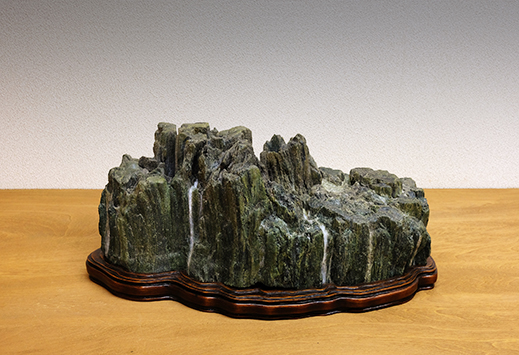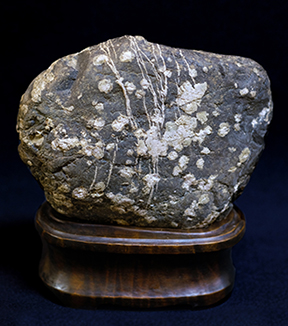 |
 |
 |
HOME > FOCUS > Spirited Stones at Chichibu Chinsekikan, the Hall of Curious Rocks |
 |
 |
Focus features two in-depth reviews each month of fine art, architecture and design exhibitions and events at art museums, galleries and alternative spaces around Japan. The contributors are non-Japanese residents of Japan. |
|
|
 |
 |
 |
Spirited Stones at Chichibu Chinsekikan, the Hall of Curious Rocks
Susan Rogers Chikuba |
 |
Curator Yoshiko Hayama brings a zeal for learning and her warm sense of humor to the Hall of Curious Rocks. She keeps illustrated mineralogy books on hand to introduce visitors young and old to all kinds of stone lore, from prehistoric pigment-making to fossils and precious gems. Photo by Susan Rogers Chikuba |
The land outside your train window grows steadily greener as you travel the 80 kilometers northwest from Ikebukuro to Chichibu, Tokyo's suburban sprawl giving way to steep forested slopes. When you alight at Seibu Chichibu station you'll find yourself surrounded by mountains and, depending on the hour, by the hikers, campers, and day-trekking rock hounds this area attracts in droves. Geopark Chichibu, an 89,250-hectare conglomeration of national and prefectural parks and a growing center of geotourism in the Kanto area, is headquartered right here at the station.
You're standing at the southeastern edge of a primordial seabed, and those peaks all around you are the result of seismic forces pushing up hundreds of millions of years ago from Izu Peninsula 200 kilometers to the south. The diverse strata of igneous, metamorphic and sedimentary rock that converge here have made the Chichibu Basin a thriving center of geologic study and, from olden times, a major source of precious metals and building materials. Japan's first copper coins, minted in 708, were made of ore mined here, and the limestone quarries of Mount Buko are where much of the cement you just left behind in Tokyo comes from. A 1,300-meter-high mass of sediment from ancient coral reefs, this muscular mountain is Chichibu's symbol and popular with hikers, but its strip-mined face is a harsh reminder of all that we take from our environment.
 |
|
Entitled Waterfalls of the Tepuis, Guiana Highlands, South America, this magnificent suiseki viewing stone was a favorite of Chinsekikan founder Shoji Hayama. It was discovered by a friend in Chichibu's Kuroya valley near the remains of the Wado copper mine. Photo by Jeff Amas |
A short taxi ride away in Kami Kagemori, Yoshiko Hayama runs Chichibu Chinsekikan, or the Hall of Curious Rocks. Established in 1990 by her father, Shoji Hayama, the museum holds well over 1,000 specimens he collected over five decades before his death in 2010. Some 700 of those on display are jinmenseki -- stones whose pockmarks, holes, and otherwise weatherworn features resemble faces.
The jinmenseki exhibits are interactive. There's a stack of empty tags on offer and Yoshiko is happy to field proposals for the unnamed ones -- see if you can win her approval. “Presley,” christened by Shoji, seems a perfect caricature -- full lips slightly twisted, quizzically raised eyebrows over deep-set eyes, and the legendary pompadour. Photos by Jeff Amas |
The endearing quirkiness of the collection has made the museum a darling of Japanese television and print media. Much of that interest has to do with the inspired captions naming the rocks for the celebrities, politicians, and anime characters they resemble -- Elvis Presley, Mikhail Gorbachev, and John F. Kennedy among them. Even if you don't follow Japan's entertainment world closely enough to get all of the likenesses and inside jokes, you can still enjoy the whimsy behind these accidents of nature.
Yoshiko arranged these two in a set she entitled Kuchigenka, "Having a Spat." Photo by Jeff Amas |
Yoshiko's husband, a retired sushi chef, drove me to one of the riverbank rock fields his father-in-law frequented, and demonstrated how Shoji spent his Sunday mornings. As a rock hound and beachcomber myself I had imagined him covering miles along the river on each excursion but in fact his method was to sit and -- you guessed it -- leave no stone unturned. Once he had picked up each rock within reach and flipped it over for signs of some telltale expressive feature, he would stand up and move on to the next patch. The specimens he collected this way over some 50 years average to about two finds a month. Shoji must have been a very patient man.
Sushi Chef received its title from one of the museum's school-age patrons. Two stones likened to Edvard Munch's The Scream named themselves. Photos by Jeff Amas |
Shoji's first passion as a collector was suiseki, the classic Chinese art of stone appreciation. Through naturally occurring serendipities of shape, markings, color, and texture, these viewing stones or scholars' stones (gongshi in Chinese) evoke distant mountain ranges, islands at sea, waterfalls, and seaside cliffs. Still others represent flora, fauna and mythical creatures. More than just pretty objects to look at, as uncontrived representations of the universe and its workings in miniature, suiseki are also a means of meditation. Chinsekikan has about 60 or so on display. To explore such auguries of innocence further, mark your calendar for the 57th annual Exhibition of Japanese Suiseki Masterpieces at Meiji Shrine in Tokyo, 7 to 11 June. Some 80 prized stones submitted from around the country will be shown.
 |
|
 |
|
The styling of the base in relation to the object is an important aspect of suiseki art; Shoji hand-carved all of his stands himself. Shown here are Mother and Child and Baikaseki (Plum-Blossom Stone). Photos by Jeff Amas |
These lovable rocks showed at the Tomonotsu Museum in Hiroshima as part of an exhibition entitled Greetings from the Spiritual World. Photo by Jeff Amas |
All images are by permission of Chichibu Chinsekikan. |
 |
 |
Susan Rogers Chikuba
Susan Rogers Chikuba, a Tokyo-based writer, editor and translator, has been following popular culture, architecture and design in Japan for three decades. She covers the country's travel, art, literary and culinary scenes for domestic and international publications. |
|
 |
|
|
 |
|
 |
|